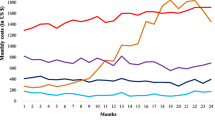Abstract
Objective
To examine the ability of various models to prospectively identify a small group of individuals with predictable high future costs that may be mitigated through disease management.
Data Sources
Diagnoses and medical costs for over a million members of employer-sponsored benefit plans from the Medstat MarketScan® Research Database (1997–1999).
Study Design
A prior cost model, a diagnosis-based (diagnostic cost group [DCG]) model and a diagnosis + prior cost (combo) model were each calibrated on 1997–1998 data and applied to 1998 data to identify 0.5%-sized ‘top groups’ of individuals most likely to be expensive in 1999 (validation). An individual with a year 2 cost over $US 10 000 was considered to be a ‘good pick’. The percentage of good picks, other features of the cost distribution, and the prevalence of ‘manageable’ i.e. commonly managed disease (diabetes mellitus, congestive heart failure, asthma/chronic obstructive pulmonary disease and depression) were compared in the three top groups. The performance of nine additional top groups — one for each model type fitted to costs top coded at each of $US100 000, $US50 000 and $US25 000 — was also investigated.
Results
Individual R2 values for the (full-range) prior cost, DCG, and combo models were 11, 16, and 21%, respectively; R2 values increased to 27% and 31% for DCG and combo models top coded at $US25 000. The full-range model top groups contained 54, 62, and 70% good picks, and 42, 53, and 48% of their cases, respectively, had at least one manageable disease. Top coding the prior cost model did not produce better top groups. However, the top groups from the DCG and combo models top coded at $US25 000 contained the most good picks (65 and 76%, respectively) and commonly managed chronic conditions (61 and 47%, respectively).
Conclusion
The DCG and combo models were better than the prior cost model for identifying groups rich in individuals who will be expensive the following year. Surprisingly, top groups based on top-coded models dominated their full-range model analogs, identifying more good picks and more people with manageable disease.







Similar content being viewed by others
References
Zook CJ, Moore F. High-cost users of medical care. N Engl J Med 1980; 302(18): 996–1002.
Anderson GF, Knickman J. Patterns of expenditures among high utilizers of medical care services. Med Care 1984; 22(2): 143–9.
Berk ML, Monheit AC. The concentration of health care expenditures, revisited. Health Aff (Millwood) 2001 Mar/April; 20(2): 9–18.
Ash A, Zhao Y, Ellis RP, et al. Finding future high cost cases: comparing priorcost versus diagnosis-based methods. Health Serv Res 2001; 36(6): 194–206.
Ash A, Porell F, Gruenberg L, et al. Adjusting medicare capitation payments using prior hospitalization data. Health Care Financ Rev 1989; 10(4): 17–29.
Ellis RP, Ash A. Refinements to the diagnostic cost group model. Inquiry 1995; 32(4): 1–12.
Ellis RP, Pope GC, Iezzoni LI, et al. Diagnosis-based risk adjustment for Medicare capitation payments. Health Care Financ Rev 1996; 17(3): 101–28.
Ash A, Ellis RP, Pope GC, et al. Using diagnoses to describe populations and predict costs. Health Care Financ Rev 2000; 21(3): 7–28.
Kronick R, Gilmer T, Dreyfus T, et al. Improving health-based payment for Medicaid beneficiaries: CDPS. Health Care Financ Rev 2000; 21(3): 29–64.
Carter GM, Bell RM, Dubois RW, et al. A clinically detailed risk information system for cost. Health Care Financ Rev 2000; 21(3): 65–92.
Pope GC, Ellis RP, Ash AS, et al. Principal inpatient diagnostic cost group models for Medicare risk adjustment. Health Care Financ Rev 2000; 21(3): 93–118.
Meenan RT, O’Keefee-Rosetti MC, Hornbrook MC, et al. The sensitivity and specificity of forecasting high-cost users of medical Care. Med Care 1999; 37(8): 815–23.
Dunn DL, Rosenblatt A, Tiaira DA, et al. A comparative analysis of methods of health risk assessment. Final report to the Society of Actuaries, 1995 Oct; Boston (MA).
Van de Ven WPMM, Ellis RP. Risk adjustment in competitive health plan markets. In: Culyer AJ, Newhouse JP, editors. Handbook in health economics. Amsterdam: North Holland, 2000: 755–845.
Pope GC, Ellis RP, Ash AS, et al. Diagnostic cost group hierarchical conditional category models for Medicare risk adjustment. Report to the Health Care Financing Administration, Contract No. 500-95-048. 2001 Dec; Waltham (MA).
Dudley RA, Medlin CA, Hammann LB, et al. The best of both worlds? Potential of hybrid prospective/concurrent risk adjustment. Med Care 2003; 41: 56–69.
Lavery LA, Ashry HR, Van Houtum W, et al. Variation in the incidence and proportion of diabetes-related amputations in minorities. Diabetes Care 1996; 19: 48–52.
American Diabetes Association. Economic consequences of diabetes mellitus in the US in 1997. Diabetes Care 1998; 21: 296–309.
Hodgson TA, Cohen AJ. Medical care expenditures for diabetes, its chronic complications, and its comorbidities. Prev Med 1999; 29: 173–86.
Adler J, Kalb C. Diabetes: an American epidemic. Newsweek 2000 Sep 4; 136: 40–7.
Cumming RB, Knutson D, Cameron BA, et al. A comparative analysis of claimsbased methods of health risk assessment for commercial populations. Final report to the Society of Actuaries, 2002 May; Minneapolis (MN).
Zhao Y, Ash AS, Ellis RP, et al. Disease burden profiles: an emerging tool for managing managed care. Health Care Manag Sci 2002; 5(3): 211–9.
Newhouse JP, Manning WG, Keeler EB, et al. Adjusting capitation rates using objective health measurers and prior utilization. Health Care Financ Rev 1989; 10(3): 41–54.
Newhouse JP. Reimbursing health plans and health providers: efficiency in production versus selection, J Econ Lit 1996; 34: 1236–63.
Acknowledgements
Support for this study was provided by DXCG, Inc., in Boston, Massachusetts, USA, which markets the software used for this project.
Author information
Authors and Affiliations
Corresponding author
Rights and permissions
About this article
Cite this article
Zhao, Y., Ash, A.S., Haughton, J. et al. Identifying Future High-Cost Cases Through Predictive Modeling. Dis-Manage-Health-Outcomes 11, 389–397 (2003). https://doi.org/10.2165/00115677-200311060-00005
Published:
Issue Date:
DOI: https://doi.org/10.2165/00115677-200311060-00005




